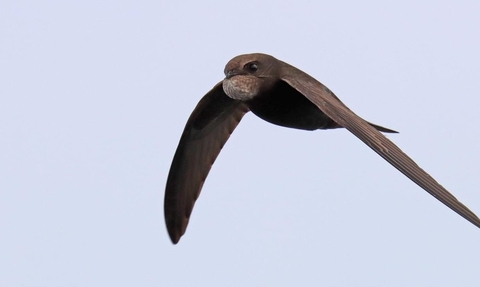
This swift has its throat full of insects to take back to its chick. (C) Nick Truby
Don't let the sound of summer fade away
Swift numbers are declining fast
Swift numbers are declining fast - in the last 25 years they have dropped by up to a half. Help us stop this trend by telling us where you've seen swifts in the county and where they are breeding.
Lets us tell you more...
Learn all about swifts
Swifts live out their lives entirely on the wing, only landing when they nest. This means that as the young fly off to Southern Africa for the winter, they will stay airborne for the next two years at least. Only when they start nesting themselves will they land again, and then only high up on a building and never on the ground or in a tree. They feed on the wing (eating insects in their hundreds), drink on the wing and even sleep on the wing!
Swifts are all black and have long scimitar-shaped wings. By comparison, swallows and house martins are smaller and also white underneath so you shouldn’t mistake a swift for either of the other similar species.
While house martins build mud nests under our eaves and swallows nest on beams, usually inside stables or barns, swifts make no visible nest at all. Instead, they fly up under our eaves, using whatever tiny crack they can find to gain entry into the roof space.
Urban populations
Swifts are essentially urban birds, nesting only on our buildings, especially older ones where small openings are still available for them. This is partly why their numbers are falling - they are excluded from their nests when buildings are renovated, new soffits or barge boards are fitted or when a house is re-roofed or has a loft conversion.
As part of the project, we can supply advice to householders, builders, architects and developers to show them how easy it is to create small entrances for swifts.
Why swifts need your help
Swifts have shared our buildings for the last 2000 years.
They nest in both older and more recent buildings where they can gain access. However, new building techniques and materials have made it impossible for swifts to gain access to any new buildings unless special provision is made eg by getting internal nest boxes fitted during construction. As a result swift populations in Derbyshire and elsewhere are under real threat.
Swift advice leaflet
How you can help
In order to keep a record of swift numbers, we need your help.
If you have seen swifts in Derbyshire please report your sightings to Derbyshire Biological Record Centre here
Thank you



